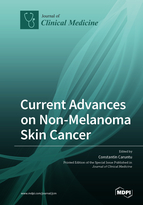Current Advances on Non-Melanoma Skin Cancer
A special issue of Journal of Clinical Medicine (ISSN 2077-0383). This special issue belongs to the section "Dermatology".
Deadline for manuscript submissions: closed (31 August 2020) | Viewed by 26639
Special Issue Editor
Interests: physiology and physiopathology of the skin and oral mucosa; dermato-oncology; in vivo reflectance confocal microscopy
Special Issues, Collections and Topics in MDPI journals
Special Issue Information
Dear Colleagues,
Non‑melanoma skin cancer (NMSC) comprises basal cell carcinoma (BCC), squamous cell carcinoma (SCC), and several rare skin tumors and is the most common malignancy affecting humans worldwide. It accounts for the vast majority of skin cancers and a large percentage of all malignant tumors. Despite the growing public awareness and scientific interest regarding the risk of skin cancer, the incidence of NMSC is still rapidly increasing. Even if most NMSCs are associated with a less aggressive behavior, they can still be locally invasive and may produce extensive destruction of neighboring structures, inducing significant morbidity. Moreover, different types or subtypes of NMSCs are associated with frequent recurrence and may carry a significant metastatic potential. As a direct consequence, NMSC has become a major burden on healthcare systems with a significant socio‑economic impact.
Hence, there is no doubt as to why these keratinocyte-derived tumors are in the spotlight of scientific interest for both fundamental research and clinical practice, and this Special Issue aims to bring together the most recent and relevant scientific research on NMSC. Studies regarding the complex inherited and environmental factors that can trigger tumor initiation and progression may offer a new perspective on skin cancer prevention. Investigation of new markers of skin carcinogenesis may contribute to the development of novel diagnostic, staging, and prognosis strategies for skin cancer and could lead to the design of more sophisticated and individually tailored treatment protocols. Improvements related to non-invasive or minimally invasive diagnostic tools and treatment methods may ameliorate the discomfort of patients while also reducing the costs associated with therapy. Moreover, the development of new techniques for early diagnosis of NMSCs could reduce morbidity, ensuring more efficient treatment with better aesthetic and functional results.
Dr. Constantin Caruntu
Guest Editor
Manuscript Submission Information
Manuscripts should be submitted online at www.mdpi.com by registering and logging in to this website. Once you are registered, click here to go to the submission form. Manuscripts can be submitted until the deadline. All submissions that pass pre-check are peer-reviewed. Accepted papers will be published continuously in the journal (as soon as accepted) and will be listed together on the special issue website. Research articles, review articles as well as short communications are invited. For planned papers, a title and short abstract (about 100 words) can be sent to the Editorial Office for announcement on this website.
Submitted manuscripts should not have been published previously, nor be under consideration for publication elsewhere (except conference proceedings papers). All manuscripts are thoroughly refereed through a single-blind peer-review process. A guide for authors and other relevant information for submission of manuscripts is available on the Instructions for Authors page. Journal of Clinical Medicine is an international peer-reviewed open access semimonthly journal published by MDPI.
Please visit the Instructions for Authors page before submitting a manuscript. The Article Processing Charge (APC) for publication in this open access journal is 2600 CHF (Swiss Francs). Submitted papers should be well formatted and use good English. Authors may use MDPI's English editing service prior to publication or during author revisions.
Keywords
- non-melanoma skin cancer
- basal cell carcinoma
- squamous cell carcinoma
- prevention
- early diagnosis
- treatment
- new technologies







